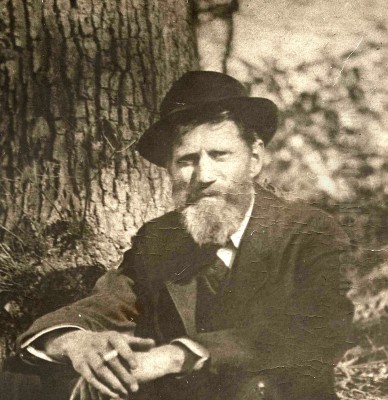
Emil Carlsen stands as a significant figure in American art history, a painter celebrated for his exquisite still lifes, evocative landscapes, and luminous marine paintings. Born in Denmark but forging his career primarily in the United States, Carlsen blended the meticulous observation of the Old Masters with the light-infused palette of Impressionism, creating a unique and enduring artistic legacy. His dedication to craft, his mastery of light and texture, and his quiet, contemplative compositions earned him the respect of critics and collectors alike, securing his place as a leading artist of the late 19th and early 20th centuries. Beyond his own creations, Carlsen was also an influential teacher, shaping a generation of artists on both the East and West Coasts.
Early Life and Formative Years
Søren Emil Carlsen was born in Copenhagen, Denmark, on October 19, 1853. His initial artistic training was not in painting but in architecture, which he studied at the Royal Danish Academy of Fine Arts in Copenhagen. This architectural background may have contributed to the strong sense of structure and composition evident in his later paintings. While at the Academy, he also received some foundational instruction in drawing and painting, hinting at his future path.
Like many Europeans seeking opportunity and new horizons, Carlsen emigrated to the United States in 1872, initially settling in the bustling city of Chicago. This move marked the beginning of his American journey and the gradual shift from architectural pursuits to a full commitment to painting. The artistic environment in America, though still developing its own distinct identity, offered Carlsen a new context in which to hone his skills and find his voice.
Chicago and Early Artistic Development
In Chicago, Carlsen's talents were quickly recognized. He secured a position teaching drawing and painting, becoming one of the first instructors at the Chicago Academy of Design, which would later evolve into the renowned Art Institute of Chicago. This early teaching role indicates his proficiency even at a relatively young stage in his career. However, the demands of teaching sometimes conflicted with his desire to focus solely on his own art.
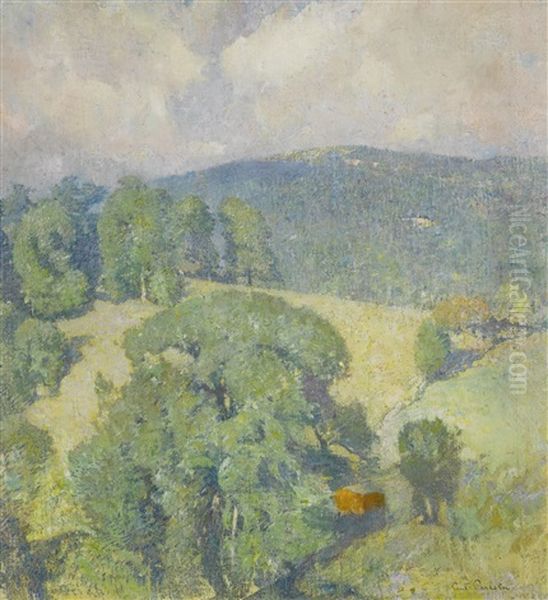
During these formative years in the US, Carlsen worked diligently to establish himself. He likely undertook various artistic jobs, possibly including architectural drafting, to support himself while developing his painting technique. It was a period of exploration and refinement, as he absorbed the influences around him while searching for his unique artistic expression. He began to gravitate towards the genres that would define his career: still life and landscape.
Parisian Influence and the Shadow of Chardin
A pivotal period in Carlsen's development occurred during his time spent in Paris. Like many American artists of his generation, he sought the artistic stimulation and academic rigor of the French capital. While there, he immersed himself in the study of both the Old Masters in the Louvre and the contemporary movements, particularly Impressionism, that were revolutionizing French art.
One artist, in particular, left an indelible mark on Carlsen: the 18th-century French master of still life, Jean-Baptiste-Siméon Chardin. Carlsen deeply admired Chardin's ability to imbue humble, everyday objects with dignity and profound beauty through the subtle manipulation of light, texture, and composition. He studied Chardin's techniques closely, absorbing lessons about tonal harmony, tactile surfaces, and the quiet poetry of the mundane. This influence would remain a cornerstone of Carlsen's still life practice throughout his career, though he filtered it through a more modern, Impressionist-influenced sensibility.
The Art of Stillness: Carlsen's Still Lifes
Emil Carlsen is perhaps best remembered as a master of still life painting. He elevated the genre in American art, bringing to it a level of technical refinement and aesthetic sensitivity that few could match. His still lifes are characterized by their simple, elegant arrangements, often featuring a limited number of objects carefully placed against a neutral background. Common subjects included gleaming copper pots, brass kettles, lustrous ceramics (including Oriental porcelain), game birds, fish, and occasionally flowers, such as roses.
What set Carlsen's still lifes apart was his extraordinary ability to render texture and light. He captured the cool sheen of metal, the delicate translucency of porcelain, the soft plumage of birds, and the varied surfaces of fruits and vegetables with uncanny realism. His technique was often meticulous and painstaking, involving multiple layers of paint, scraping down areas, and reapplying pigment to achieve the desired effect of depth and luminosity. This careful layering, combined with a sophisticated understanding of tonal values, created compositions that were both visually convincing and deeply atmospheric.
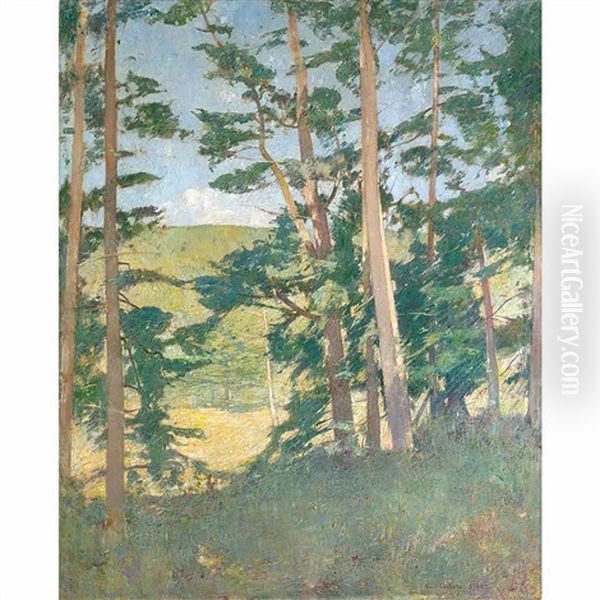
His works in this genre, such as the subtly toned Study in Grey (1906) or arrangements like Roses and Oriental Porcelain, exemplify his approach. They are not merely accurate depictions but meditative studies in form, color, and light. Critics often noted the "subtle and elusive" quality of his work, suggesting an indirect expression of emotion through the quiet arrangement of objects. In 1916, Carlsen himself championed the genre in a published article, emphasizing the importance and challenges of still life painting, perhaps in response to its sometimes-secondary status compared to historical or figurative works. His dedication ensured his reputation as the "American Chardin."
Expanding Horizons: Landscapes and Seascapes
While renowned for still life, Carlsen was also a highly accomplished painter of landscapes and marine scenes. As his career progressed, he increasingly turned his attention to the natural world, finding inspiration in the countryside of Connecticut and the power of the sea. He spent considerable time in Falls Village, Connecticut, where the rolling hills, woods, and changing seasons provided ample subject matter.
His landscapes, such as Connecticut Hillside (circa 1920), often share the tonal sensitivity and atmospheric quality of his still lifes. He was less concerned with topographical accuracy than with capturing the mood and light of a particular place and time. His palette could range from muted, silvery tones in overcast scenes to brighter, more vibrant hues under sunlight, reflecting the influence of American Impressionism. Works like Clearing Beyond the Trees (1928) showcase his ability to handle the complexities of foliage and distance with a sense of harmony and balance.
Carlsen also painted powerful seascapes, drawn to the dynamic energy and shifting light of the ocean. His depictions of the coast or open water demonstrate his skill in rendering the movement of waves and the vastness of the sea and sky. A notable example of his engagement with grand natural phenomena is his painting Niagara, capturing the awe-inspiring power of the falls. Whether depicting quiet rural corners or dramatic natural wonders, Carlsen brought his characteristic sensitivity to light and atmosphere to his landscape and marine work.
A Respected Educator
Throughout his career, Emil Carlsen dedicated significant time and energy to teaching. His early role at the Chicago Academy of Design was followed by a highly influential period in San Francisco. From 1887 to 1891, he served as the Director of the California School of Design (later the San Francisco Art Institute). During his tenure, he significantly shaped the curriculum and mentored numerous students who would go on to become notable artists.
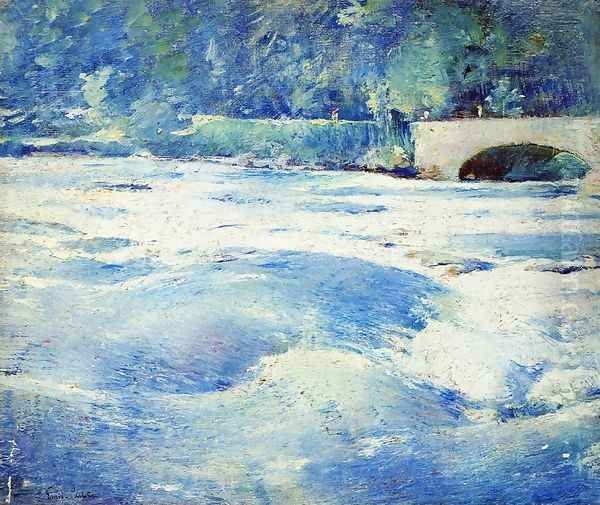
Among his students in San Francisco were figures like Guy Rose, who became a leading California Impressionist, and Evelyn McCormick, another important painter associated with the California scene, as well as Edward Aitchison. Carlsen's teaching philosophy emphasized the evolutionary nature of art and his belief in the potential for America to become a major art center. He was known for his high standards and reportedly expressed frustration with students he felt lacked sufficient dedication or confidence, believing that serious art education required serious commitment. He also offered private instruction through the Art Students League of San Francisco.
Later in his career, while based primarily on the East Coast, he continued to be associated with major art institutions and educational circles. While the provided source material lists prominent artists like Childe Hassam, J. Alden Weir, Kenyon Cox, Henry Siddons Mowbray, and William Merritt Chase as his "students," this is likely inaccurate given their established careers and status as Carlsen's contemporaries. It is more probable that he taught alongside these figures at institutions like the National Academy of Design or the Art Students League of New York, or interacted with them as colleagues and fellow members of artistic societies, rather than having them as formal pupils. His influence as an educator, however, particularly from his San Francisco period, remains undisputed.
Navigating the Art World: Exhibitions and Recognition
Carlsen's path to recognition was not without its challenges. Early in his career, he faced periods of economic difficulty, at one point reportedly auctioning off his works to alleviate financial pressure. However, his persistence and the undeniable quality of his art gradually earned him acclaim and patronage. His association with prominent dealers, particularly the Macbeth Gallery in New York, was crucial. Macbeth Gallery represented many leading American artists and provided Carlsen with a consistent venue for exhibiting and selling his work from the late 1890s onwards, significantly boosting his visibility and reputation on the East Coast.
He also exhibited regularly at other prestigious venues, including the National Academy of Design (where he was elected an Associate in 1904 and a full Academician in 1906), the Pennsylvania Academy of the Fine Arts, and the Art Institute of Chicago. In San Francisco, he was active in the Bohemian Club, a social and cultural organization where he frequently displayed his paintings.
Over the years, Carlsen received numerous awards and honors, cementing his status in the American art establishment. These included medals at major expositions like the Panama-Pacific International Exposition in San Francisco (1915) and prizes from institutions such as the National Academy of Design and the Carnegie Institute in Pittsburgh. His works entered major public and private collections across the country.
Circle of Contemporaries and Artistic Milieu

Emil Carlsen was part of a vibrant artistic community, particularly associated with American Impressionism. His closest artistic friendship was likely with Julian Alden Weir. Carlsen eventually settled near Weir's farm in Branchville, Connecticut, and the two artists shared a deep mutual respect and aesthetic kinship. Weir's presence and the surrounding landscape undoubtedly influenced Carlsen's landscape painting.
The area around Weir's farm and nearby Cos Cob attracted numerous artists associated with American Impressionism, creating a supportive and stimulating environment. Carlsen interacted with many key figures of the movement, including John Henry Twachtman, another close friend of Weir known for his atmospheric landscapes. While not formally a member of "The Ten American Painters" (a group founded by Hassam, Weir, Twachtman, and others to organize their own exhibitions), Carlsen's style and social connections placed him firmly within their orbit.
His contemporaries included leading figures like Childe Hassam, William Merritt Chase (a highly influential artist and teacher himself), Frank W. Benson, Edmund C. Tarbell, Thomas Wilmer Dewing, and Willard Metcalf – all artists exploring variations of Impressionism and Tonalism. In New York, he shared a studio for a time with Arthur Mason. These connections highlight Carlsen's integration into the mainstream of American art at the turn of the century. He was a respected peer among the most accomplished painters of his day.
Later Life, Legacy, and Family
Emil Carlsen continued to paint actively into his later years, maintaining his high standards of craftsmanship and his dedication to capturing the beauty of light and form. He remained primarily based in New York and Connecticut. Unlike some artists whose styles underwent radical transformations, Carlsen largely remained true to the aesthetic vision he developed earlier in his career, refining his approach rather than abandoning it.
A interesting aspect of his personal life, noted in the source material, is that he apparently never married and dedicated his life wholeheartedly to his art. However, this seems to be an error in the provided text, as historical records confirm he married Luela Mary Ruby in 1896, and they had a son, Dines Carlsen (1901-1966). Dines followed in his father's footsteps, becoming a successful painter in his own right, particularly known for still lifes that clearly show his father's influence, thus continuing the family's artistic legacy.
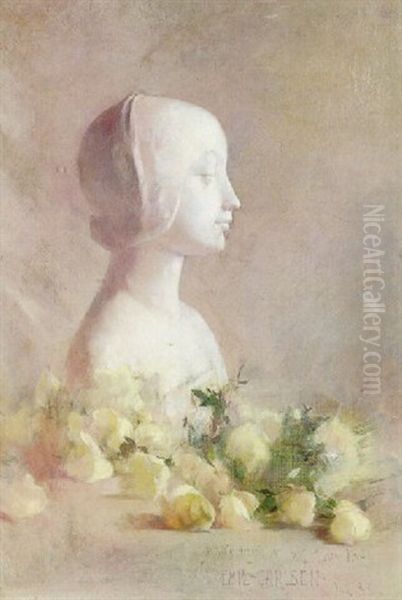
Emil Carlsen passed away in New York City on January 2, 1932. His death marked the end of a long and distinguished career. Today, his works are held in the permanent collections of major museums across the United States, including the Metropolitan Museum of Art, the Smithsonian American Art Museum, the National Gallery of Art, the Art Institute of Chicago, the Dallas Museum of Art, the Brooklyn Museum, the Fine Arts Museums of San Francisco, and many others. His paintings continue to be admired for their technical brilliance, serene beauty, and timeless appeal.
Conclusion
Emil Carlsen carved a unique niche in American art history. As a Danish immigrant who embraced the artistic currents of his adopted country, he masterfully synthesized the meticulous craft of traditional European painting, particularly the legacy of Chardin, with the light-filled aesthetics of Impressionism. He achieved renown as arguably America's foremost still life painter of his era, finding profound beauty in the humble objects of everyday life. Simultaneously, he created evocative landscapes and seascapes that captured the atmosphere and spirit of the American scene. As an influential educator, he helped shape the next generation of artists. Through his dedication, technical virtuosity, and poetic sensibility, Emil Carlsen left behind a body of work that continues to resonate with viewers, celebrated for its quiet elegance and masterful rendering of light and stillness.